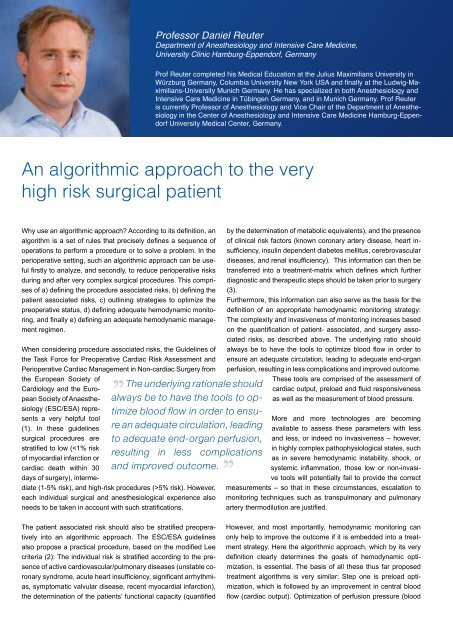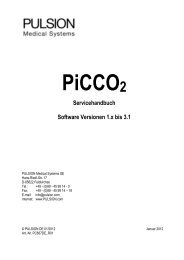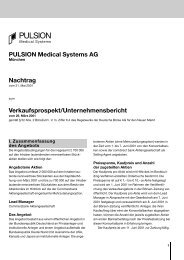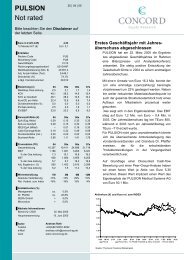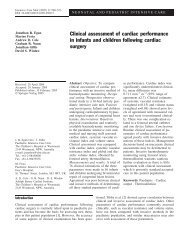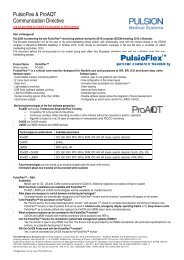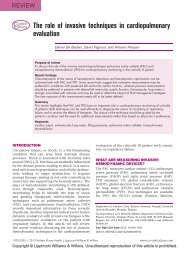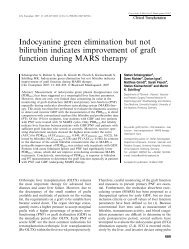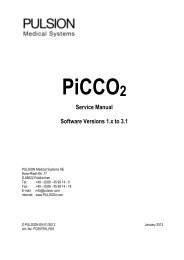download as .pdf - PULSION Medical Systems SE
download as .pdf - PULSION Medical Systems SE
download as .pdf - PULSION Medical Systems SE
You also want an ePaper? Increase the reach of your titles
YUMPU automatically turns print PDFs into web optimized ePapers that Google loves.
An algorithmic approach to the very<br />
high risk surgical patient<br />
Why use an algorithmic approach? According to its definition, an<br />
algorithm is a set of rules that precisely defines a sequence of<br />
operations to perform a procedure or to solve a problem. In the<br />
perioperative setting, such an algorithmic approach can be useful<br />
firstly to analyze, and secondly, to reduce perioperative risks<br />
during and after very complex surgical procedures. This comprises<br />
of a) defining the procedure <strong>as</strong>sociated risks, b) defining the<br />
patient <strong>as</strong>sociated risks, c) outlining strategies to optimize the<br />
preoperative status, d) defining adequate hemodynamic monitoring,<br />
and finally e) defining an adequate hemodynamic management<br />
regimen.<br />
When considering procedure <strong>as</strong>sociated risks, the Guidelines of<br />
the T<strong>as</strong>k Force for Preoperative Cardiac Risk Assessment and<br />
Perioperative Cardiac Management in Non-cardiac Surgery from<br />
the European Society of<br />
”<br />
Cardiology and the European<br />
Society of Anaesthesiology<br />
(ESC/ESA) represents<br />
a very helpful tool<br />
(1). In these guidelines<br />
surgical procedures are<br />
stratified to low (5% risk). However,<br />
each individual surgical and anesthesiological experience also<br />
needs to be taken in account with such stratifications.<br />
The patient <strong>as</strong>sociated risk should also be stratified preoperatively<br />
into an algorithmic approach. The ESC/ESA guidelines<br />
also propose a practical procedure, b<strong>as</strong>ed on the modified Lee<br />
criteria (2): The individual risk is stratified according to the presence<br />
of active cardiov<strong>as</strong>cular/pulmonary dise<strong>as</strong>es (unstable coronary<br />
syndrome, acute heart insufficiency, significant arrhythmi<strong>as</strong>,<br />
symptomatic valvular dise<strong>as</strong>e, recent myocardial infarction),<br />
the determination of the patients’ functional capacity (quantified<br />
Professor Daniel Reuter<br />
Department of Anesthesiology and Intensive Care Medicine,<br />
University Clinic Hamburg-Eppendorf, Germany<br />
Prof Reuter completed his <strong>Medical</strong> Education at the Julius Maximilians University in<br />
Würzburg Germany, Columbia University New York USA and finally at the Ludwig-Maximilians-University<br />
Munich Germany. He h<strong>as</strong> specialized in both Anesthesiology and<br />
Intensive Care Medicine in Tübingen Germany, and in Munich Germany. Prof Reuter<br />
is currently Professor of Anesthesiology and Vice Chair of the Department of Anesthesiology<br />
in the Center of Anesthesiology and Intensive Care Medicine Hamburg-Eppendorf<br />
University <strong>Medical</strong> Center, Germany.<br />
The underlying rationale should<br />
always be to have the tools to optimize<br />
blood flow in order to ensure<br />
an adequate circulation, leading<br />
to adequate end-organ perfusion,<br />
resulting in less complications<br />
and improved outcome.kk<br />
”<br />
by the determination of metabolic equivalents), and the presence<br />
of clinical risk factors (known coronary artery dise<strong>as</strong>e, heart insufficiency,<br />
insulin dependent diabetes mellitus, cerebrov<strong>as</strong>cular<br />
dise<strong>as</strong>es, and renal insufficiency). This information can then be<br />
transferred into a treatment-matrix which defines which further<br />
diagnostic and therapeutic steps should be taken prior to surgery<br />
(3).<br />
Furthermore, this information can also serve <strong>as</strong> the b<strong>as</strong>is for the<br />
definition of an appropriate hemodynamic monitoring strategy:<br />
The complexity and inv<strong>as</strong>iveness of monitoring incre<strong>as</strong>es b<strong>as</strong>ed<br />
on the quantification of patient- <strong>as</strong>sociated, and surgery <strong>as</strong>sociated<br />
risks, <strong>as</strong> described above. The underlying ratio should<br />
always be to have the tools to optimize blood flow in order to<br />
ensure an adequate circulation, leading to adequate end-organ<br />
perfusion, resulting in less complications and improved outcome.<br />
These tools are comprised of the <strong>as</strong>sessment of<br />
cardiac output, preload and fluid responsiveness<br />
<strong>as</strong> well <strong>as</strong> the me<strong>as</strong>urement of blood pressure.<br />
More and more technologies are becoming<br />
available to <strong>as</strong>sess these parameters with less<br />
and less, or indeed no inv<strong>as</strong>iveness – however,<br />
in highly complex pathophysiological states, such<br />
<strong>as</strong> in severe hemodynamic instability, shock, or<br />
systemic inflammation, those low or non-inv<strong>as</strong>ive<br />
tools will potentially fail to provide the correct<br />
me<strong>as</strong>urements – so that in these circumstances, escalation to<br />
monitoring techniques such <strong>as</strong> transpulmonary and pulmonary<br />
artery thermodilution are justified.<br />
However, and most importantly, hemodynamic monitoring can<br />
only help to improve the outcome if it is embedded into a treatment<br />
strategy. Here the algorithmic approach, which by its very<br />
definition clearly determines the goals of hemodynamic optimization,<br />
is essential. The b<strong>as</strong>is of all these thus far proposed<br />
treatment algorithms is very similar: Step one is preload optimization,<br />
which is followed by an improvement in central blood<br />
flow (cardiac output). Optimization of perfusion pressure (blood


